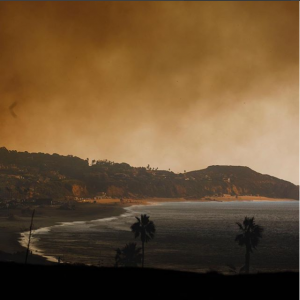California wildfires leave devastation in their wake
The campfire is out. Communities set off on a path to rebuild.
November 29, 2018
A firefighter walks through the blaze of the Woolsey fire in Malibu, California.
Wildfires in the media by Nitya Thakkar
Burning across 1,667,855 acres in California, 7,579 fires in 2018 have left mass destruction in their wake. The fires have caused more than $2.975 billion in damage. People across the nation have been reaching out to help those impacted by the destructive flames.
Social media has been used by celebrities to help reunite people with those impacted by the fires. Facebook and Instagram pages have been created for the sole purpose of helping share photos of people (and even pets), in the hopes that someone may have seen them and be able to help reunite people.
Celebrities, actors, musicians and entertainers have also taken advantage of their status in order to positively help those displaces by the fires. For example, after Miley Cyrus’s home was destroyed in a fire she took to social media to urge her followers to donate to foundations that help people displaced by fires. Furthermore, she donated $500,000 to the Malibu Foundation, which is an organization created to aid the community after the Woolsey Fire. Celebrity chef, Guy Fieri, recently helped cook Thanksgiving meals for 15,000 evacuees from the fires and also for first responders. Khloe Kardashian bought bottled water and eye drops for firefighters, hoping to provide aid. Sandra Bullock Donated $100,000 to the Humane Society to help animal victims. Ellen Degeneres donated $100,000 to the Los Angeles Fire Department Foundation. Lady Gaga delivered pizzas to a Red Cross shelter at the Pacific Palisades High School.
Yet the relief efforts extend past simply celebrity figures. Countless organizations have been started and funded by citizens across the nation. The catastrophe was nearly contained as of Nov. 25, but there’s no questioning the devastation brought on by California’s deadliest wildfire season in history.
If interested in donating or helping relief efforts, go online and search for an organization. There are dozens of them that all share the same goal: to help those whose lives have been dramatically impacted by the wildfires.
Environmental perspective by Isabel Gisser
Two weeks, 85 dead, 249 missing, and the fire rages on. The catastrophe was nearly contained as of Nov. 25, but there’s no questioning the devastation brought on by California’s deadliest wildfire season in history.
Even thousands of miles outside California, the wildfires have had disastrous impact. Minnesota spent its summer on constant air quality alert due to smoke traveling across the country. The airborne particulate matter from wildfires that leads to air quality alerts can cause premature death, anxiety, hypertension, and strokes among many other major health effects— it’s frightening. Nearly the entire country has been affected by the devastation in California. With the enormous scale of the fires, the effects can be expected to be disastrous as well. But why was California’s wildfire season so intense and destructive to begin with?

Smoke from the Woolsey fire hangs over the coast of Malibu.
California currently has the ideal conditions for a massive blaze–dropping humidity levels, warm nights, declining snowpack, and increased evaporation. The underlying culprit behind these phenomena? Climate change. Thanks to warming temperatures, the wildfire season has extended into California’s already short rainy season. Diminished snowpack leads to dry vegetation during the summer months, further fueling fires. And though the quantity of wildfires has not increased in the last decade, the intensity and pace at which fires spread has grown exponentially. What’s particularly frightening about these “megafires” as said by California governor, Jerry Brown, is that they’ve become the “new normal.”
While California has the strongest wild land firefighting agency in the nation, it’s no match to the omnipresent threat of climate change. Temperatures will only continue to rise, and wildfires will only continue to grow. It’s hard to think of the future in a positive light with global warming looming over our heads. But there are ways to diminish the effects of climate change.
Earth relies on the atmosphere to shield the planet from solar radiation— just enough radiation can permeate the protective layer to keep Earth at a livable temperature. Some of that radiation also hits the Earth and deflects back into space. However, greenhouse gases thicken that protective layer and act like a blanket, trapping that excess radiation. This makes average temperatures increase, thus, global warming and the climate changes that make California more susceptible to massive wildfires.
To prevent the recurrence of these catastrophic disasters and to decrease that sense of impending doom some feed, reduce greenhouse gas emissions and the carbon footprint. Drive less, buy local, reduce, reuse, recycle. There are dozens of simple ways to reduce negative environmental impact.